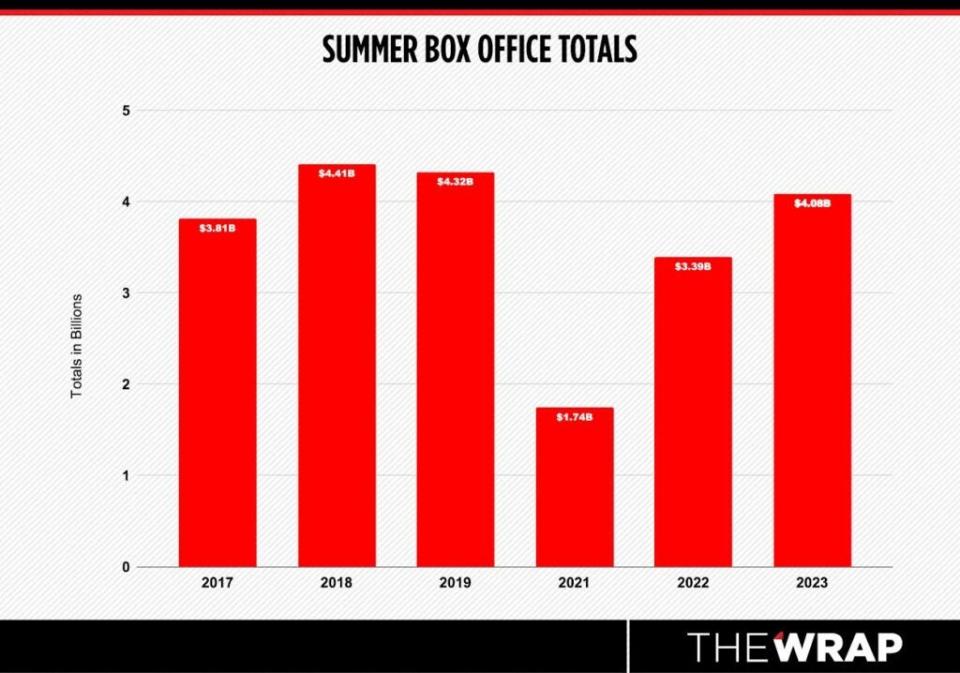5 Lessons Learned From a $4 Billion Summer at the Box Office | Chart

The 2023 summer box office season was many things, but never boring. Theaters saw meaningful progress as their industry continued to recover from the pandemic shutdown, while studios navigated through four months of record-setting hits and stunning flops.
The final tally for the summer: $4.08 billion, 20% above last year’s $3.39 billion total and just 5.5% behind the $4.32 billion recorded in 2019 (though that total doesn’t include the opening week of “Avengers: Endgame.”)
The foremost factor in this year-over-year surge was undoubtedly the pop culture craze that was “Barbenheimer.” Combined, Warner Bros.’ “Barbie” and Universal’s “Oppenheimer” saw over $920 million in domestic grosses and over $2.2 billion worldwide. Thanks to them and “The Super Mario Bros. Movie,” 2023 may well be the first time in 22 years that the top three films at the box office weren’t sequels or comic-book films.

Of course, comic-book movies did have a huge presence this summer, though the ubiquitous genre’s record was mixed between huge hits and spectacular crashes. While Disney and Sony’s Marvel offerings struck chords with audiences, interest in Warner Bros.’ DC franchise has fallen to an all-time low as the studio puts its bets on James Gunn turning it around in two years.
And on top of it all, Hollywood faces a sustainability crisis as the pandemic and inflation have caused budgets on tentpole films to spiral. What exactly it will take to get it under control while providing audiences the big-screen spectacle they expect is unclear. And a double strike has called the financial sustainability of the entire entertainment industry, including that of working-class writers and actors, into question.
It’s a lot to take in, so let’s break it down into three good things and three bad things that happened this summer.
Filmmakers’ voices matter
Consider the three highest grossing films of this summer: “Barbie” ($613 million domestic/$1.38 billion worldwide), “Oppenheimer” ($310 million domestic/$851 million worldwide) and “Guardians of the Galaxy Vol. 3” ($359 million domestic/$845.5 million worldwide).
None of these films are, strictly speaking, original. They all have something they’re adapting from — toys, comic books, or American history. But that raw material was shaped by directors with distinct cinematic styles, and they ended up being the films that audiences came out in droves for.
Greta Gerwig’s sharply humorous take on the Barbie doll and its intersections with feminism turned “Barbie” into a pop-culture phenomenon. Christopher Nolan drew in his enormous global fan base with a tale about the dawn of the Atomic Age that also captivated casual moviegoers perhaps drawn in by “Barbenheimer” memes.
And while the murmurs about the Marvel Cinematic Universe jumping the shark have gotten even louder after critical duds like “Secret Invasion,” James Gunn gave the franchise another win with “Guardians 3,” a trilogy capper that saw Gunn lean even harder into his distinct blend of weird, sometimes gross visuals and genuine love for characters like Rocket Raccoon, Drax, Star-Lord and all the obscure comic book characters he’s turned into icons since the first “Guardians” came out nine years ago.
While the last seven weeks of summer 2022 were marked by plummeting grosses as the rate of popular new releases quickly dried up thanks to pandemic backlogs, this summer ended with Warner Bros.’ “Barbie” and Universal’s “Oppenheimer” becoming the top-grossing and third-highest-grossing films of the year respectively.
Insiders at Warner Bros. and Universal have told TheWrap they credit Gerwig and Nolan above all else for the success of those films, with Warner insiders also noting that the success of “Guardians 3” is why they have faith that Gunn can restore DC to its former glory. The lesson seems thuddingly obvious, but it’s clear: find talented filmmakers and let them cook.

Dead-end franchises
Conversely, there are some franchises that have clearly reached the end of their shelf life and will either have to be retired or significantly overhauled.
The latter will be the case for DC, which suffered arguably the most high-profile bomb of the year with “The Flash,” a film that hit theaters with much hype only to fail to even gross $300 million worldwide. In fact, all three DC films released this year have grossed less than Dwayne Johnson’s “Black Adam,” a film that last year was seen as one of the worst-performing DC films ever.
Gunn’s reboot of DC isn’t the only longtime franchise that will have to be altered.
Without the help of the Chinese box office, “Transformers: Rise of the Beasts” failed to cross $500 million worldwide, showing that this incarnation of the Autobots, first introduced by Michael Bay in 2007 and sporting $200 million-plus budgets, has run its course.
Paramount’s solution? Make the next “Transformers” offering an animated origin story that will be strikingly different visually and produced for less than half the cost of the Bay series. The mid-budget success of Paramount’s animated film “Teenage Mutant Ninja Turtles: Mutant Mayhem” shows the potential of this strategy.
And then there are the series that won’t be continuing, like “Indiana Jones and the Dial of Destiny,” a film that was already set to be Harrison Ford’s farewell to his most famous role but which only made $381 million against a COVID-inflated $300 million-plus budget. Left behind by a disinterested Gen Z demo, it’s clear that Indy’s time in theaters has come and gone.
It’s the budget, stupid
The massive budget of “Dial of Destiny” is just one example of another huge problem that studios faced: the pandemic made many of these summer’s films far too expensive.
Along with the big bombs, there were films like Universal’s “Fast X” and Paramount’s “Mission: Impossible — Dead Reckoning,” which saw significant budget overruns due to pandemic shooting delays and increased costs. Though both of those films performed consistently, at least in North America, with recent franchise installments, those budget overruns have eaten into their profitability.
Even considering the fact that these films helped make money for their studios in other ways besides ticket sales — Universal and Paramount insiders told TheWrap that home-viewing revenue from past “Fast & Furious” and “Mission: Impossible” titles surged when these new chapters came out — studios will have to find a way to get spending on these tentpoles under control. While the end of COVID-19 safety protocols will help reduce costs, it will be some time before Hollywood knows what constitutes a realistic budget for a top-of-the-line potential blockbuster in this post-shutdown world.
There’s always potential for surprises
For every bomb like “Flash” or “Indy,” there was another surprise at the box office that was far more pleasant. More than three years after “Spider-Man: Into the Spider-Verse” first arrived before a moviegoing audience uncertain whether they wanted to see a different Spidey in animated form, that film’s fanbase has grown to the point that its critically acclaimed “Across the Spider-Verse” has become Sony’s biggest animated hit ever.
“Elemental,” a film that suffered the worst opening weekend in Pixar history, slowly won over audiences to the point that it has reached break-even territory with over $475 million worldwide, signaling that hope may still be alive for the once-mighty animation studio to return to its former glory.
And then there’s the hit that no one saw coming: “Sound of Freedom,” the biggest independently-produced box office success in over a decade. With just under $182 million grossed in the U.S., it has cracked the year’s top 10 charts and made up for some of the lost revenue expected from major studio flops like “The Flash.”
The strike still looms
If there’s anything this summer proved, it’s that “Top Gun: Maverick” wasn’t a fluke. Give audiences quality films, and they will come back to theaters en masse. Theater owners at CinemaCon this past spring told TheWrap that they had a lot of optimism about how this summer was going to go, and with signs that moviegoers are not only coming back but spending more on concessions, that optimism has proven to be well-founded.
But now comes a new problem: Hollywood’s writers and actors, frustrated over eroding wages, a lack of compensation for streaming work and the potential threats of AI, have spent the summer on the picket lines to pressure the studios to agree to a new contract.
While the writers’ strike put more of an immediate strain on the TV side of Hollywood, the actors’ strike has turned the screws on the film side, pushing studios into moving fall films like Sony’s “Kraven the Hunter” and Warner’s “Dune: Part Two” into 2024. Other films may likewise move.
The longer the strikes go on, the greater the strain it will put on the studios’ release slates and increase the likelihood of theaters having to once again weather months-long periods without any major film releases like they did in 2022. For a lot of theaters, that’s a rough patch they can’t afford to deal with again, most notably AMC Theaters, which is burning through cash at a massive rate and has warned that a prolonged strike could force it into bankruptcy.
Ironically, the movie that could buy theaters some time is one that isn’t coming from any major studio at all: Taylor Swift’s “Eras Tour” concert film. Last week, the pop icon dropped the bombshell that her team is partnering with AMC and Cinemark to release the concert film in October, sending studios scrambling to move their release dates as the film earned $26 million from the first day of presales alone.
The first $100 million-plus opening weekend in October might come not from a Hollywood studio, but from a left-field partnership between a generational music star and the biggest theater chain in the world. With studios struggling to figure out how to respond to arguably the most organized front Hollywood’s labor force has ever assembled, who could fault exhibitors for finding their own backup plan?
The post 5 Lessons Learned From a $4 Billion Summer at the Box Office | Chart appeared first on TheWrap.

